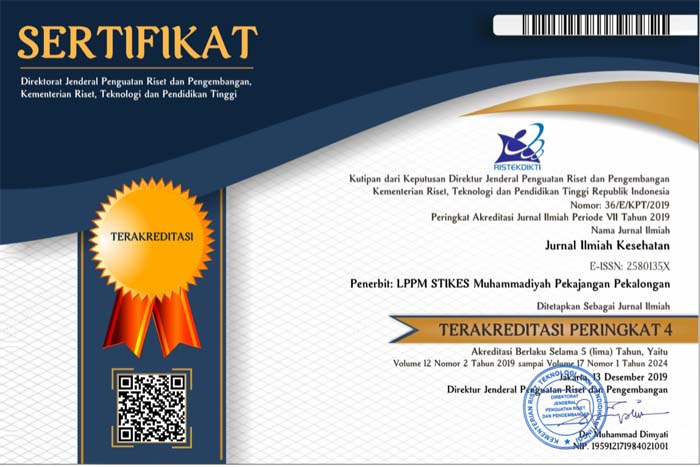Pola Pernapasan Dan Faktor Lingkungan Dalam Pengendalian Gejala Asma Bronkial Pada Anak-Anak
DOI:
https://doi.org/10.48144/jiks.v17i2.1783Keywords:
Asma bronchial, faktor lingkungan, pola pernapasanAbstract
Asma bronkial pada anak-anak merupakan masalah kesehatan yang meningkat secara global. Penelitian ini bertujuan untuk mengeksplorasi hubungan antara paparan debu, bulu hewan, frekuensi pernapasan, dan polutan udara dengan kejadian asma berulang pada anak-anak. Penelitian ini merupakan penelitian kuantitatif yang melibatkan survei longitudinal pada anak-anak dengan asma bronkial. Metode pengumpulan data melibatkan pemantauan pola pernapasan, seperti frekuensi napas, analisis lingkungan di rumah dan lingkungan sekolah. Pengumpulan data juga akan melibatkan wawancara dengan anak-anak dan orang tua mereka untuk mendapatkan wawasan yang lebih mendalam tentang pola pernapasan dan faktor lingkungan sehari-hari. Sampel dalam penelitian ini yaitu anak sekolah dasar usia 6-12 tahun yang mengalami asma berjumlah 38 responden. Hasil penelitian menunjukkan bahwa paparan debu (p=0,007) dan bulu hewan (p=0,002) meningkatkan risiko asma berulang pada anak-anak, dengan anak-anak yang memiliki pola pernapasan (p=0,000) yang tidak teratur memiliki kemungkinan lebih besar untuk mengalami serangan. Paparan polutan udara juga meningkatkan risiko dan keparahan asma pada anak-anak (p=0,008). Paparan debu, bulu hewan, frekuensi pernapasan yang tidak teratur, dan polutan udara memiliki hubungan yang signifikan dengan kejadian asma berulang pada anak-anak. Untuk mengatasi masalah ini, diperlukan upaya pencegahan yang melibatkan pengelolaan debu dan alergen di rumah, pendidikan tentang pola pernapasan yang sehat, dan advokasi untuk kebijakan lingkungan yang mendukung kualitas udara bersih. Integrasi pendekatan ini dapat merancang strategi yang holistik untuk meningkatkan kesehatan pernapasan anak-anak dan mengurangi dampak asma bronkial.
References
L. Murrison, E. Brandt, J. Myers, and G. Hershey, “JCI - Environmental exposures and mechanisms in allergy and asthma development.” Accessed: Feb. 09, 2024. [Online]. Available: https://www.jci.org/articles/view/124612
E. Rovira et al., “Asthma, respiratory symptoms and lung function in children living near a petrochemical site,” Environmental Research, vol. 133, pp. 156–163, Aug. 2014, doi: 10.1016/j.envres.2014.05.022.
M. W. Pijnenburg et al., “Monitoring asthma in children,” European Respiratory Journal, vol. 45, no. 4, pp. 906–925, Apr. 2015, doi: 10.1183/09031936.00088814.
M. Depner et al., “Clinical and Epidemiologic Phenotypes of Childhood Asthma,” Am J Respir Crit Care Med, vol. 189, no. 2, pp. 129–138, Jan. 2014, doi: 10.1164/rccm.201307-1198OC.
A. Bush, “Pathophysiological Mechanisms of Asthma,” Frontiers in Pediatrics, vol. 7, 2019, Accessed: Feb. 09, 2024. [Online]. Available: https://www.frontiersin.org/articles/10.3389/fped.2019.00068
L. Panico, B. Stuart, M. Bartley, and Y. Kelly, “Asthma Trajectories in Early Childhood: Identifying Modifiable Factors,” PLOS ONE, vol. 9, no. 11, p. e111922, Nov. 2014, doi: 10.1371/journal.pone.0111922.
T. C. Lewis et al., “Air pollution and respiratory symptoms among children with asthma: Vulnerability by corticosteroid use and residence area,” Science of The Total Environment, vol. 448, pp. 48–55, Mar. 2013, doi: 10.1016/j.scitotenv.2012.11.070.
A. Moeller et al., “Monitoring asthma in childhood: lung function, bronchial responsiveness and inflammation,” European Respiratory Review, vol. 24, no. 136, pp. 204–215, Jun. 2015, doi: 10.1183/16000617.00003914.
M. Trivedi and E. Denton, “Asthma in Children and Adults—What Are the Differences and What Can They Tell us About Asthma?,” Frontiers in Pediatrics, vol. 7, 2019, Accessed: Feb. 09, 2024. [Online]. Available: https://www.frontiersin.org/articles/10.3389/fped.2019.00256
S. C. Dharmage, J. L. Perret, and A. Custovic, “Epidemiology of Asthma in Children and Adults,” Frontiers in Pediatrics, vol. 7, 2019, Accessed: Feb. 09, 2024. [Online]. Available: https://www.frontiersin.org/articles/10.3389/fped.2019.00246
K. L. Milligan, E. Matsui, and H. Sharma, “Asthma in Urban Children: Epidemiology, Environmental Risk Factors, and the Public Health Domain,” Curr Allergy Asthma Rep, vol. 16, no. 4, p. 33, Mar. 2016, doi: 10.1007/s11882-016-0609-6.
F. Liu et al., “Asthma and asthma related symptoms in 23,326 Chinese children in relation to indoor and outdoor environmental factors: The Seven Northeastern Cities (SNEC) Study - ScienceDirect.” Accessed: Feb. 09, 2024. [Online]. Available: https://www.sciencedirect.com/science/article/abs/pii/S0048969714011334
S. W. Lee et al., “Short-term effects of multiple outdoor environmental factors on risk of asthma exacerbations: Age-stratified time-series analysis,” Journal of Allergy and Clinical Immunology, vol. 144, no. 6, pp. 1542-1550.e1, Dec. 2019, doi: 10.1016/j.jaci.2019.08.037.
M. E. Kuruvilla, K. Vanijcharoenkarn, J. A. Shih, and F. E.-H. Lee, “Epidemiology and risk factors for asthma,” Respiratory Medicine, vol. 149, pp. 16–22, Mar. 2019, doi: 10.1016/j.rmed.2019.01.014.
P. A. W. Suwaryo, M. D. Kupitasari, and E. Setianingsih, “Kontrol Asma Menggunakan Latihan Breathing Retraining,” Prosiding University Research Colloquium, pp. 58–63, May 2020.
A. J. Burbank, A. K. Sood, M. J. Kesic, D. B. Peden, and M. L. Hernandez, “Environmental determinants of allergy and asthma in early life,” Journal of Allergy and Clinical Immunology, vol. 140, no. 1, pp. 1–12, Jul. 2017, doi: 10.1016/j.jaci.2017.05.010.
P. A. W. Suwaryo, S. Aminah, B. Waladani, E. Setianingsih, and R. Setianingsih, “Physiotherapy Treatment of Hypertension Patients to Reduce Headache Using Slow Stroke Back Massage Therapy,” presented at the International Conference on Sustainable Innovation on Health Sciences and Nursing (ICOSI-HSN 2022), Atlantis Press, Dec. 2022, pp. 176–182. doi: 10.2991/978-94-6463-070-1_22.
J. Alwarith et al., “The role of nutrition in asthma prevention and treatment,” Nutr Rev, vol. 78, no. 11, pp. 928–938, May 2020, doi: 10.1093/nutrit/nuaa005.
G. Ding, R. Ji, and Y. Bao, “Risk and Protective Factors for the Development of Childhood Asthma,” Paediatric Respiratory Reviews, vol. 16, no. 2, pp. 133–139, Mar. 2015, doi: 10.1016/j.prrv.2014.07.004.
H. Hyrkäs, T. M. Ikäheimo, J. J. K. Jaakkola, and M. S. Jaakkola, “Asthma control and cold weather-related respiratory symptoms,” Respiratory Medicine, vol. 113, pp. 1–7, Apr. 2016, doi: 10.1016/j.rmed.2016.02.005.
B. Galobardes et al., “Childhood Wheezing, Asthma, Allergy, Atopy, and Lung Function: Different Socioeconomic Patterns for Different Phenotypes,” American Journal of Epidemiology, vol. 182, no. 9, pp. 763–774, Nov. 2015, doi: 10.1093/aje/kwv045.
S. Esposito et al., “Impact of air pollution on respiratory diseases in children with recurrent wheezing or asthma,” BMC Pulmonary Medicine, vol. 14, no. 1, p. 130, Aug. 2014, doi: 10.1186/1471-2466-14-130.
T. F. Carr and E. Bleecker, “Asthma heterogeneity and severity,” World Allergy Organization Journal, vol. 9, p. 41, Jan. 2016, doi: 10.1186/s40413-016-0131-2.
R. Beasley, A. Semprini, and E. A. Mitchell, “Risk factors for asthma: is prevention possible?,” The Lancet, vol. 386, no. 9998, pp. 1075–1085, Sep. 2015, doi: 10.1016/S0140-6736(15)00156-7.
G. D’Amato et al., “Effects on asthma and respiratory allergy of Climate change and air pollution,” Multidiscip Respir Med, vol. 10, no. 1, p. 39, Dec. 2015, doi: 10.1186/s40248-015-0036-x.












